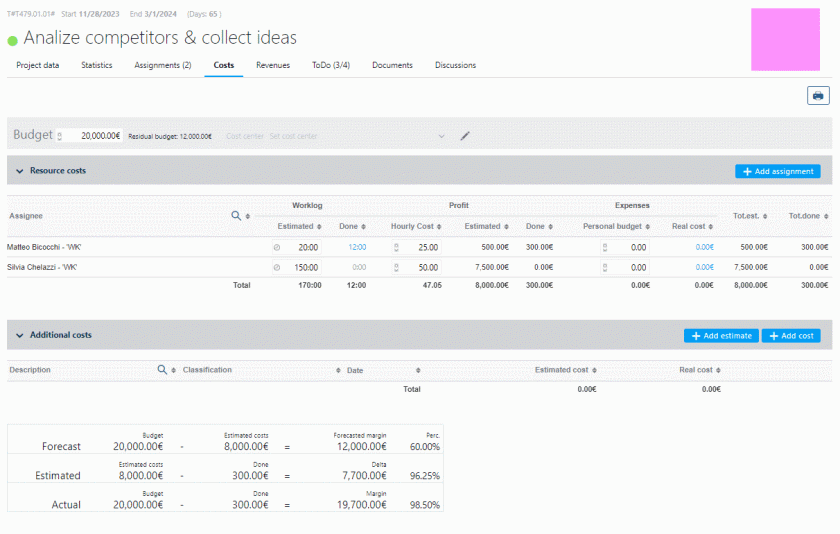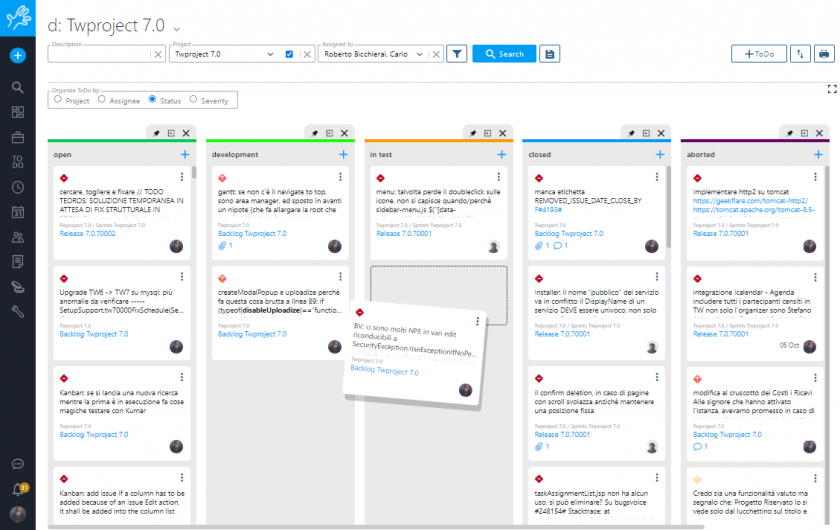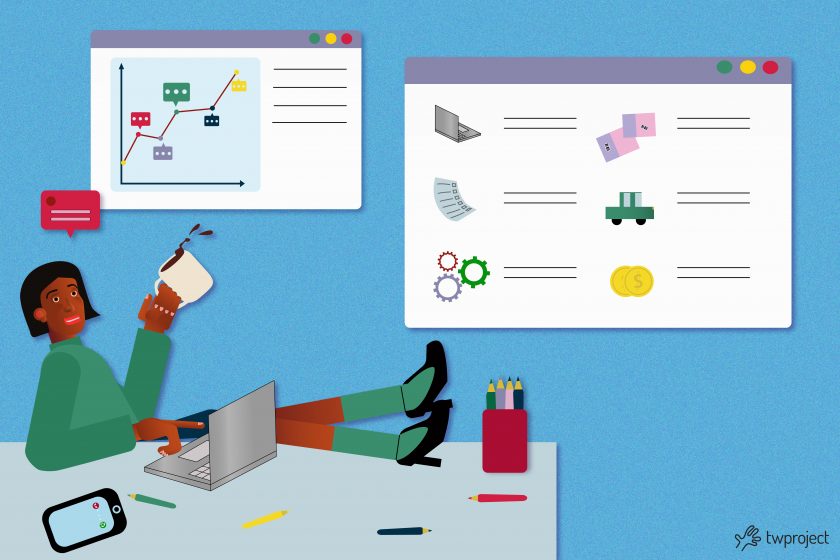What are the main challenges for production companies when managing projects and how can they best be addressed?
In this article, we will try to frame and summarise the internal management issues affecting the manufacturing industry sector and see how to face them.
CONTENT
- Foreword: the need for coordinated actions
- 1. Challenges of production companies: managing complex projects
- 1.1. Gantt work schedule with flexible dependencies
- 1.2. Iterative projects
- 1.3. Unified cost management
- 2. Challenges of production companies: managing resources across departments
- 2.1. Coordination between different departments
- 2.2. Transparency
- 2.3. Communication
- Twproject: a single solution to the challenges faced by production companies in managing projects
Production companies represent a vitally important sector, and at the same time a large and diverse one, with companies of various sizes, disparate structures, different geographical location and context.
Therefore, it is not easy to make a synthesis that links all the various instances together, but we have tried to find patterns that we will explore here.
Finally, we will provide practical examples to manage the most complex projects involving production companies.
Foreword: the need for coordinated actions
Production companies are usually larger than others and consist of different departments, such as the sales department, purchasing, administration, logistics and actual production.
Project managers working in this key area need specific skills and techniques for project planning and management.
An experienced project manager who implements the right strategies will be able to speed up production time, streamline work, and reduce the time between conception and production.
We will now look in detail at the main needs of production companies, which we have divided into two macro-areas:
- the management of complex and multi-layered projects
- the management of large and diverse teams
In order to make project management as efficient as possible, it will be useful to implement some coordinated measures and actions, which we will explore in detail.

1. Challenges in projects of production companies: managing complex projects
Complex projects involving several departments can be a factor in the wastage of energy within production companies.
To avoid this risk, it is first of all useful to plan each project phase carefully and thoroughly from the outset.
There are several planning methods involving the design of project phases.
In any case, it is always useful to divide the project into phases and sub-phases, i.e. to set up a Work Breakdown Structure (WBS), as a first step. Breaking down a large project into smaller pieces with a hierarchical structure will be a way to approach it analytically and will be useful throughout the project execution.
1.1. Gantt work schedule with flexible dependencies
Once the project has been divided into phases, it will be possible to determine the timeframe. If there is a final deadline, all intermediate stages must be set to meet the deadline.
An efficient work schedule requires a little initial effort, but once we gain experience, it will be an essential tool for anyone who directs and coordinates projects, but also for the whole team together.
We often rely on non-specialised tools, such as classic spreadsheets. But we know that creating a Gantt chart with Excel has major limitations, such as its static nature, the lack of specific functions, and the inability to collaborate in real time.
But if, on the other hand, we use a specific software to perform this task, we will obtain a truly effective operational tool at all stages of the project.
For instance, Twproject‘s Gantt chart was created to connect the initial design phase with the production phase and to represent the execution of work in a realistic manner.

In particular, Twproject’s Gantt offers the possibility of linking phases and sub-phases in an elastic manner that is not necessarily consecutive and linear. We can in fact have:
- Finish to Start relationship, in which activity A must end before activity B begins;
- Finish to Finish relationship, in which activity B cannot end before activity A has also ended;
- Start to Start relationship, in which activity B cannot begin until A has itself begun;
- Start to Finish relationship, in which activity B cannot end until A has begun.
The latter scenario described occurs, for example, during a shift change in a production plant. Therefore, a manufacturing company should ideally have a Gantt chart that offers this possibility if it wants to plan accurately and adherently to reality.
The Gantt chart in Twproject is highly functional for this purpose and also offers numerous interactions with all the other tools in the software, enabling the rescheduling of times, assignments and other elements in the execution phase.
1.2. Iterative projects
When projects are complex, it is inevitable that some predictions made during the start-up phase may be called into question during the execution of the project. The important thing is to realise this in good time and identify the change and the reason for it.
Reviewing a problem in the production process is an operation that allows us to gain experience for future projects.
Production companies often find themselves repeating very similar projects from year to year, and it is therefore important to be able to learn from previous planning errors.
The timeline is a tool in the Gantt chart that allows you to review these errors, or changes, that occurred in the past and use them to better plan in the next time.
In addition, when repeating similar projects, it is convenient to use tools that make it easy to export previously used models and apply them to current projects.
Software such as Twproject makes it possible to clone fully or partially completed projects, which is very useful for companies that carry out repeated and predictive activities, such as the projects of manufacturing companies.
This will save a lot of time, especially if we can also clone allocations and budgets and thus have a model to follow and learn lessons from for future project management.
1.3. Unified cost management
When projects are large and complex, keeping the budget under control is one of the biggest challenges.
Keeping track of direct and indirect costs, making informed estimates, planning income and expenditure, and finally comparing the planned budget with the actual budget is a complex operation, especially if proper tools are not in use.
Once again, the use of handmade spreadsheets is not a good solution for structured companies. There are many digital tools that can be used to record expenses and keep the budget under control, but in our opinion it is good that the tool used can be integrated with project management software.
In the case of software such as Twproject, data integration is total. In fact, this project management tool has cost management functionality already built-in.

Twproject allows effortless cost and time calculations through procedures that speed up data entry and with the additional possibility of creating reports and statistics that are always updated in real time.
Its alert system in case of budget overruns in individual phases is also very useful to realise, within complex projects, where the criticalities lie.
2. Challenges in projects of production companies: managing resources across departments
Production companies are often large organisations comprising several departments, with very different requirements and compositions.
This leads to two problems that affect the complexity of project management in this type of company:
- the difficulty in finding management methods that meet the needs of different work areas
- the scattering of information among departments
Let us see in detail how to deal with these problems.
2.1. Coordination among different departments
Production companies are often faced with different work settings for different departments.
Let us take the example of organisations in which production, administration, human resources, sales departments etc. coexist, or the case of companies with foreign subsidiaries.
Working hours will, of course, be different for different offices, just as closing days or holidays will not necessarily coincide.
A tool that takes into account this multiple working hours is therefore indispensable to better manage the resource load of a project and to produce realistic estimates of delivery times.
Twproject‘s multiple calendars are an example of how flexibility can be managed: in addition to a default calendar, the software allows several calendars to be set, either on individual projects or on resources or entire departments.
The calculation of resource hours is based on the reference calendar for the given project and resource and automatically sets up time estimates, helping the project manager to make accurate and judicious planning.
2.2. Transparency
Another consequence of a complex structure in resource work management is the potential lack of transparency.
In the case of company projects, it is important that the project manager always keeps an overview of the work progress and resource load.
At the same time, however, the whole team needs to be clear about the project time schedule; that is why it is essential to use a shared management tool, within which everyone can consult the information essential to their job role.
It is also important for anyone to be able to mark the hours worked accurately and also in different ways as required.
An optimal tool makes it easy to track work time in a variety of ways (with classic timesheets, but also by setting a stopwatch and through task descriptions). Everyone will have their own method: the crucial thing is to keep track of personal and other people’s work carefully.
Having a clear and up-to-date status of the work performed will increase transparency but also the involvement of all team members in the project activities.
2.3. Communication
Lastly, let’s look at what is perhaps the main obstacle encountered when managing complex projects such as those of production companies, namely the difficulty in communication.
In large companies, it is crucial to prevent information from being scattered between one department and another.
And contrary to common belief, this is not done by increasing the number of e-mails or messages, but instead by trying to reduce the load of it.
Within large projects, there are a number of small information and requests which, if included in a continuous and exhausting exchange of e-mails, can get lost and remain unnoticed.
If, on the contrary, these are turned into ToDo’s, the most convenient tool for assigning timely tasks, it will be much easier to keep track of them.
Twproject’s ToDo’s are integrated within projects and their sub-phases, and are the collaborative tool par excellence as they allow, among other things, to attach documents, add comments and notifications.
This helps improving communication and coordination internally but also across departments, allowing work to be distributed very clearly among the various assignees.
As they are part of project phases, they can also be visualised in the Gantt diagram, and of course also in the very useful kanban visual board.

Every action performed on the ToDo is linked to the notification system in real time, allowing for a smooth yet non-invasive flow of communication.
Twproject: a single solution to the challenges faced by production companies in managing projects
Although large companies are the ones where it is most difficult to introduce new methodologies and tools, once the initial hurdle is overcome, they are ultimately the ones that benefit the most.
In a structured company it is easier for all the functions of a rich and flexible software like Twproject to be exploited in their entirety.
Large companies are the ones that make most use of training courses for the use of management tools and thus learn new skills in project management at the same time.
Twproject is a tool that is enthusiastically welcomed in companies in the production sector, because it solves huge problems such as those seen in this article and avoids wasting energy.
With Twproject, we help companies centralise project management, plan, monitor and improve communication.
With Twproject, we found a reliable platform to work smarter and more effectively, allowing resources to standardise their working methods and gain speed in planning.

If you are also willing to try out Twproject free of charge for 15 days and start managing projects as a whole with this tool, our support team will help you to set it up properly.
Just like many companies in the industry, we are confident that your organisation will optimise its project management!




